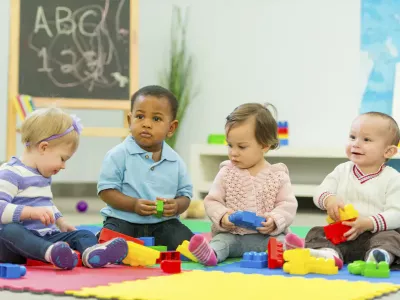Don't ignore the Terrible Twos (or threes or fours)

While child development research is fascinating, you may not think it’s much help if you’re wondering how to stop your little darling drawing on the walls (or worse). As you might have just discovered, if you’re looking for answers online you have to sift through a lot of information, trying to separate opinion from evidence-based articles, often conflicting.
For instance, depending on which internet article you read, you may be told the “terrible twos” are a reality a myth, or somewhere in between.
The reality is that children vary widely in both temperament and the age at which they reach developmental milestones. Parents also bring different life experiences and parenting styles to the mix. So while your two-year-old may be throwing regular full-blown tantrums complete with hitting and biting on a daily basis, your neighbor’s or sister’s or favorite celebrity’s kids may appear to be sailing serenely through their third year and beyond. (Bear in mind, though, that it’s not unusual for kids to behave differently in public than they do at home.) However, there’s increasing evidence to suggest that ignoring problems at this stage is not a good idea.
SHIFTING GEARS
As children transition from infanthood through the toddler years to early childhood, an amazing array of physical and mental changes are taking place. These include:
- A growing understanding that their identity is separate from their parents
- An insatiable curiosity about the world around them
- The ability to run, climb, jump, explore (and potentially hurt themselves and others)
- An increased understanding of language but a frustrating gap between their feelings and their ability to express them
Parents, meanwhile, have to also make some developmental leaps of their own. During babyhood, a parent’s job is to respond quickly to meeting their child’s needs, which are mainly for food, comfort and attention. However, parents of toddlers must learn to balance the task of meeting a child’s need for security, love and safety with their equally important need to learn to regulate their emotions and behave in socially acceptable ways.
By necessity, this will sometimes mean denying a child something they want, but don’t actually need, such as a new toy every other week, treats at the supermarket or being able to stay up past their bedtime. Whether this occurs at age two, three, four or beyond doesn’t really matter as much as recognizing that every parent finds it challenging.
The image of parenting which is often presented (either subtly or not-so-subtly) in the media and online commentary is that parents should automatically know how to deal with the so-called Terrible Twos, or any other difficult aspect of parenting. This unrealistic expectation is well past its use-by date. Rather than criticizing and undermining parents, especially those who are struggling, we should be embracing the idea of comprehensive and appropriate parenting support being readily available to EVERY parent.
